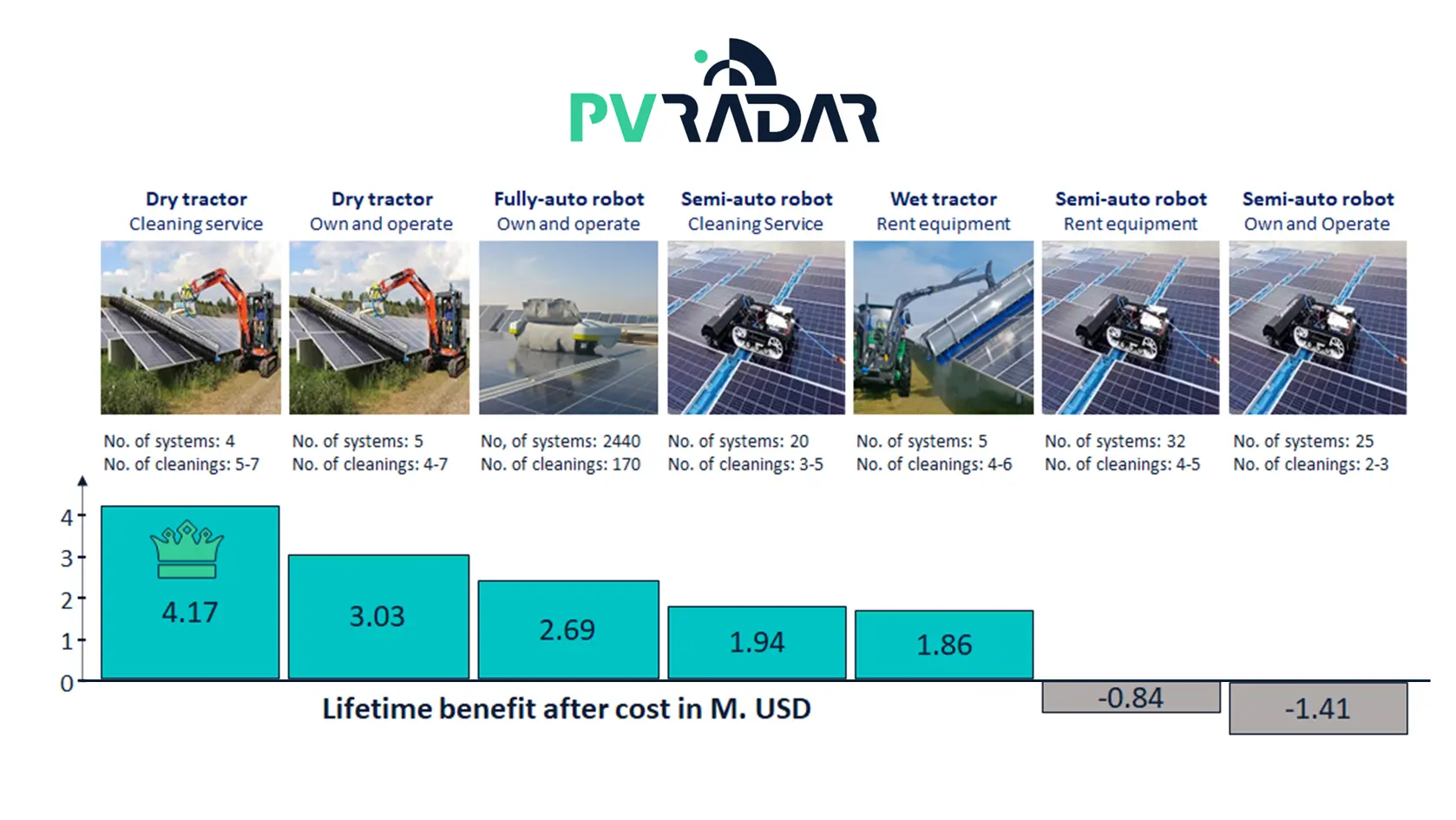
Soiling assessment and cleaning optimization with PVRADAR
The decision on how to clean your PV plant is complex. Not cleaning can result in huge revenue losses, while suboptimal strategies can generate more costs than benefits. In order to find the most cost-effective cleaning strategy, many different scenarios have to be calculated and compared, taking into account all technical details and related costs. PVRADAR solves this challenge in an easy, fast and accurate way, letting you get the most out of your PV project.
Selecting the right cleaning strategy is a complex decision
As of today, there is a wide variety of available cleaning technologies, each one with different costs, cleaning speeds, component lifetimes and maintenance needs. Autonomous cleaning robots allow a very high cleaning frequency but require an initial investment. Tractor and brush solutions are more flexible but result in higher soiling losses. With so many variables to be considered, choosing the most appropriate one for your particular case becomes a highly complex task. To find the best strategy, the following questions need to be answered:
- which is the most convenient technology for my specific case?
- how many systems to consider?
- whether to buy or rent them?
- how often to clean?
- how to operate them?
It all depends on your site conditions
Naturally, the problem is not the same everywhere. For some sites, high rainfall can resolve a big part of the problem and therefore the questions may be easy to solve. Something similar happens in desert areas where fully-autonomous robots run a bit ahead as the most logic solution. However, the situation changes for areas with intermittent rainfall and variable soiling where the selection of the best strategy turns into an exercise of a much higher difficulty.
The optimal can’t be found using traditional methods
Excel, usually in combination with yield simulation tools and even sometimes python scripts, is the approach that is commonly used to try to solve this problem. Unfortunately, at a certain point this methodology turns no longer convenient. This approach is limited in terms of technical complexity, very time-consuming and both the results and the process behind are difficult to explain to the rest of the team and most important: to decision makers.
How do we solve the soiling problem?
The picture above shows how an optimization-process looks like using PVRADAR. Here, combinations of different cleaning technologies and operative strategies were compared in the context of a specific project.
The optimization model first optimizes parameters for each solution individually, iterating through different number of systems and cleaning dates. Then, it selects the overall best solution.
PVRADAR integrates critical information such as soiling rate and rain from satellite data, in order to ensure accurate results and improve the user's experience. To account for the variability of site conditions, we take into account historical data to define the most likely scenarios for the future.
Our financial model translates energy gains into revenue increases and compares them against the additional investment and operational costs of the cleaning system. Within minutes our users find the cleaning strategy that best fits the power plant and that maximizes the financial result of the project.
Such a big problem, must be solved
PVRADAR takes on particular importance today, when it is more than ever clear that soiling is a huge problem for photovoltaic plants performance . A new report from IEA PVPS [1] has recently stated that soiling is, after irradiance, the single most influential factor impacting solar photovoltaic performance. Globally, it is estimated that every year soiling accounts for revenue losses of 3-5 billion EUR. This is an impressive and, at the same time, unacceptable scenario considering the level of investment in this industry and its relevance for the energy transition goals.
Choosing the right cleaning strategy is and will remain essential to ensure the high production efficiency of your project. The good news is that it is no longer an impossible task. With PVRADAR, you can find the optimal cleaning strategy for your PV power plant in a matter of minutes and finally solve the soiling problem.
[1] Ilse, K., Micheli, L., Figgis, B. W., Lange, K., Daßler, D., Hanifi, H., Wolfertstetter, F., Naumann, V., Hagendorf, C., Gottschalg, R., & Bagdahn, J., "Techno-economic assessment of soiling losses and mitigation strategies for solar power generation," in Joule, vol. 3, issue 10, pp. 1-19, 2019.
